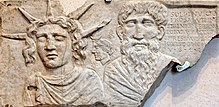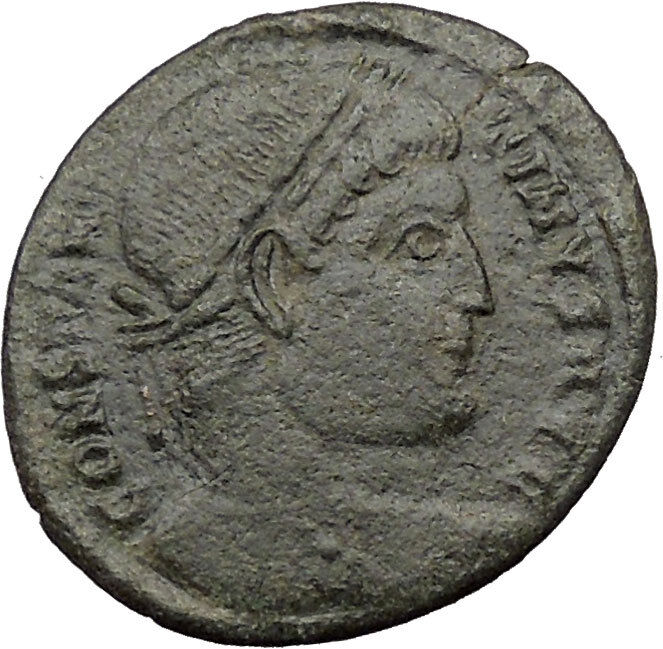|
Valerian I
–
Roman Emperor
: 253-260 A.D. –
Silver Antoninianus 21mm (2.66 grams) Rome mint circa 255-257 A.D.
Reference: RIC 106; Cohen 140; Sear5 9950 (whip)
IMP C P LIC VALERIANVS PF AVG, radiate, draped bust right
ORIENS AVGG, Sol standing left, right hand raised, left hand holding whip
.
You are bidding on the exact item pictured,
provided with a Certificate of Authenticity and Lifetime Guarantee of
Authenticity.
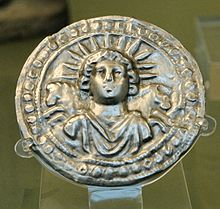
Roman Imperial
repoussé
silver
disc of Sol Invictus (3rd
century), found at
Pessinus
(British
Museum) Sol Invictus (“Unconquered Sun”) was the official
sun god
of the later
Roman Empire
and a patron of soldiers. In 274
the Roman emperor
Aurelian
made it an official
cult alongside the traditional Roman cults. Scholars disagree whether
the new deity was a refoundation of the ancient
Latin
cult of
Sol
,
a revival of the cult of
Elagabalus
or completely new.The god was
favored by emperors after Aurelian and appeared on their coins until
Constantine
.The last inscription referring to
Sol Invictus dates to 387 AD and there were enough devotees in the 5th century
that
Augustine
found it necessary to preach against
them.
It is commonly claimed that the date of 25 December for
Christmas
was selected in order to correspond
with the Roman festival of Dies Natalis Solis Invicti, or “Birthday of
the Unconquered Sun”, but this view is challenged
Invictus as
epithet
Invictus
(“Unconquered, Invincible”) was an
epithet
for
several deities
of
classical Roman religion
, including the supreme
deity
Jupiter
, the war god
Mars
,
Hercules
,
Apollo
and
Silvanus
.[8]
Invictus was in use from the 3rd century BC, and was well-established as
a
cult
title when applied to
Mithras
from the 2nd century onwards. It has a
clear association[vague]
with solar deities and solar monism; as such, it became the preferred epithet of
Rome’s traditional
Sol
and the novel, short-lived Roman state cult
to
Elagabalus
, an
Emesan
solar deity who headed Rome’s official
pantheon under his
namesake emperor
.
The earliest dated use of Sol invictus is in a dedication from Rome,
AD 158. Another, stylistically dated to the 2nd century AD, is inscribed on a
Roman
phalera
: “inventori lucis soli invicto
augusto” (to the contriver of light, sol invictus augustus ). Here
“augustus” is most likely a further epithet of Sol as “august” (an elevated
being, divine or close to divinity), though the association of Sol with the
Imperial house would have been unmistakable and was already established in
iconography and stoic monism. These are the earliest attested examples of Sol as
invictus, but in AD 102 a certain
Anicetus
restored a shrine of Sol; Hijmans
(2009, 486, n. 22) is tempted “to link Anicetus’ predilection for Sol with his
name, the
Latinized
form of the Greek word ἀνίκητος,
which means invictus“.
Elagabalus
The first sun god consistently termed invictus was the
provincial Syrian
god
Elagabalus
. According to the
Historia Augusta
, the
teenaged Severan heir
adopted the name of his
deity and brought his cult image from Emesa to Rome. Once installed as emperor,
he neglected Rome’s traditional State deities and promoted his own as Rome’s
most powerful deity. This ended with his murder in 222.
The Historia Augusta refers to the deity Elagabalus as “also called
Jupiter and Sol” (fuit autem Heliogabali vel Iovis vel Solis).This has
been seen as an abortive attempt to impose the Syrian sun god on Rome;
but because it is now clear that the Roman cult of Sol remained
firmly established in Rome throughout the Roman period,this Syrian
Sol Elagabalus
has become no more relevant to
our understanding of the Roman
Sol
than, for example, the Syrian
Jupiter Dolichenus
is for our understanding of
the Roman Jupiter.
Aurelian
The Roman gens
Aurelian was associated with the cult
of Sol. After his victories in the East, the Emperor
Aurelian
thoroughly reformed the Roman cult of
Sol, elevating the sun-god to one of the premier divinities of the Empire. Where
previously priests of Sol had been simply
sacerdotes
and tended to belong to lower
ranks of Roman society, they were now pontifices and members of the new
college of pontifices
instituted by Aurelian.
Every pontifex of Sol was a member of the senatorial elite, indicating that the
priesthood of Sol was now highly prestigious. Almost all these senators held
other priesthoods as well, however, and some of these other priesthoods take
precedence in the inscriptions in which they are listed, suggesting that they
were considered more prestigious than the priesthood of Sol.Aurelian also built
a new temple for Sol, bringing the total number of temples for the god in Rome
to (at least) four[21]
He also instituted games in honor of the sun god, held every four years from AD
274 onwards.
The identity of Aurelian’s Sol Invictus has long been a subject of scholarly
debate. Based on the
Historia Augusta
, some scholars have argued
that it was based on
Sol Elagablus
(or Elagabla) of
Emesa
. Others, basing their argument on
Zosimus
, suggest that it was based on the
Helios
, the solar god of
Palmyra
on the grounds that Aurelian placed and
consecrated a cult statue of Helios looted from Palmyra in the temple of Sol
Invictus. Professor Gary Forsythe discusses these arguments and add a third more
recent one based on the work of Steven Hijmans. Hijmans argues that Aurelian’s
solar deity was simply the traditional Greco-Roman Sol Invictus.
Constantine
Emperors portrayed Sol Invictus on their official coinage, with a wide range
of legends, only a few of which incorporated the epithet invictus, such
as the legend SOLI INVICTO COMITI, claiming the Unconquered Sun
as a companion to the Emperor, used with particular frequency by Constantine.
Statuettes of Sol Invictus, carried by the standard-bearers,
appear in three places in reliefs on the
Arch of Constantine
. Constantine’s official
coinage continues to bear images of Sol until 325/6. A
solidus
of Constantine as well as a gold
medallion from his reign depict the Emperor’s bust in profile twinned (“jugate”)
with Sol Invictus, with the legend INVICTUS CONSTANTINUS
Constantine decreed (March 7, 321) dies Solis—day of the sun, “Sunday“—as
the Roman day of rest [CJ3.12.2]:
- On the venerable day of the Sun let the magistrates and people residing
in cities rest, and let all workshops be closed. In the country however
persons engaged in agriculture may freely and lawfully continue their
pursuits because it often happens that another day is not suitable for
grain-sowing or vine planting; lest by neglecting the proper moment for such
operations the bounty of heaven should be lost.
Constantine’s triumphal arch was carefully positioned to align with the
colossal statue of Sol
by the
Colosseum
, so that Sol formed the dominant
backdrop when seen from the direction of the main approach towards the arch.[26]
Sol and the
other Roman Emperors
Berrens
deals with coin-evidence of Imperial connection to the Solar
cult. Sol is depicted sporadically on imperial coins in the 1st and 2nd
centuries AD, then more frequently from
Septimius Severus
onwards until AD 325/6.
Sol invictus appears on coin legends from AD 261, well before the reign of
Aurelian.
Connections between the imperial radiate crown and the cult of
Sol are postulated.
Augustus
was posthumously depicted with radiate
crown, as were living emperors from
Nero (after AD 65) to
Constantine
. Some modern scholarship interprets
the imperial radiate crown as a divine, solar association rather than an overt
symbol of Sol; Bergmann calls it a pseudo-object designed to disguise the divine
and solar connotations that would otherwise be politically controversial
but there is broad agreement that coin-images showing the
imperial radiate crown are stylistically distinct from those of the solar crown
of rays; the imperial radiate crown is depicted as a real object rather than as
symbolic light. Hijmans argues that the Imperial radiate crown represents the
honorary wreath awarded to
Augustus
, perhaps posthumously, to commemorate
his victory at the
battle of Actium
; he points out that
henceforth, living emperors were depicted with radiate crowns, but state divi
were not. To Hijmans this implies the radiate crown of living emperors as a link
to Augustus. His successors automatically inherited (or sometimes acquired) the
same offices and honours due to Octavian as “saviour of the Republic” through
his victory at Actium, piously attributed to Apollo-Helios. Wreaths awarded to
victors at the Actian Games were radiate.
Sol
Invictus and Christianity and Judaism

Mosaic of Christ as
Sol
or
Apollo-Helios
in Mausoleum M in the
pre-4th-century necropolis beneath[33]
St. Peter’s in the Vatican
, which
many interpret as representing Christ
The
Philocalian calendar
of AD 354 gives a festival
of “Natalis Invicti” on 25 December. There is limited evidence that this
festival was celebrated before the mid-4th century.
The idea that Christians chose to celebrate the birth of Jesus on 25 December
because this was the date of an already existing festival of the Sol Invictus
was expressed in an annotation to a manuscript of a work by 12th-century Syrian
bishop
Jacob Bar-Salibi
. The scribe who added it
wrote: “It was a custom of the Pagans to celebrate on the same 25 December the
birthday of the Sun, at which they kindled lights in token of festivity. In
these solemnities and revelries the Christians also took part. Accordingly when
the doctors of the Church perceived that the Christians had a leaning to this
festival, they took counsel and resolved that the true Nativity should be
solemnised on that day.”
This idea became popular especially in the 18th and 19th centuries
and is still widely accepted.
In the judgement of the Church of England Liturgical Commission, this view
has been seriously challenged
by a view based on an old tradition, according to which the
date of Christmas was fixed at nine months after 25 March, the date of the
vernal equinox, on which the
Annunciation
was celebrated.
The Jewish calendar date of 14 Nisan was believed to be that
of the beginning of creation, as well as of the Exodus and so of Passover, and
Christians held that the new creation, both the death of Jesus and the beginning
of his human life, occurred on the same date, which some put at 25 March in the
Julian calendar.[40][42][43]
It was a traditional Jewish belief that great men lived a whole number of years,
without fractions, so that Jesus was considered to have been conceived on 25
March, as he died on 25 March, which was calculated to have coincided with 14
Nisan.[44]
Sextus Julius Africanus
(c.160 – c.240) gave 25
March as the day of creation and of the conception of Jesus.
The tractate De solstitia et aequinoctia conceptionis et
nativitatis Domini nostri Iesu Christi et Iohannis Baptistae falsely
attributed to
John Chrysostom
also argued that Jesus was
conceived and crucified on the same day of the year and calculated this as 25
March.
A passage of the Commentary on the prophet Daniel by
Hippolytus of Rome
, written in about 204, has
also been appealed to.
Among those who have put forward this view are Louis Duchesne,Thomas J.
Talley, David J. Rothenberg, J. Neil Alexander, and Hugh Wybrew.
Not all scholars who view the celebration of the birth of Jesus on 25
December as motivated by the choice of the winter solstice rather than
calculated on the basis of the belief that he was conceived and died on 25 March
agree that it constituted a deliberate Christianization of a festival of the
Birthday of the Unconquered Sun. Michael Alan Anderson writes:
Both the sun and Christ were said to be born anew on December 25. But
while the solar associations with the birth of Christ created powerful
metaphors, the surviving evidence does not support such a direct association
with the Roman solar festivals. The earliest documentary evidence for the
feast of Christmas makes no mention of the coincidence with the winter
solstice. Thomas Talley has shown that, although the Emperor Aurelian’s
dedication of a temple to the sun god in the Campus Martius (C.E. 274)
probably took place on the ‘Birthday of the Invincible Sun’ on December 25,
the cult of the sun in pagan Rome ironically did not celebrate the winter
solstice nor any of the other quarter-tense days, as one might expect. The
origins of Christmas, then, may not be expressly rooted in the Roman
festival.
The same point is made by Hijmans: “It is cosmic symbolism…which inspired
the Church leadership in Rome to elect the southern solstice, December 25, as
the birthday of Christ … While they were aware that pagans called this day the
‘birthday’ of Sol Invictus, this did not concern them and it did not play any
role in their choice of date for Christmas.” He also states that, “while the
winter solstice on or around December 25 was well established in the Roman
imperial calendar, there is no evidence that a religious celebration of Sol on
that day antedated the celebration of Christmas”.
The Oxford Companion to Christian Thought also remarks on the
uncertainty about the order of precedence between the celebrations of the
Birthday of the Unconquered Sun and the birthday of Jesus: “This ‘calculations’
hypothesis potentially establishes 25 December as a Christian festival before
Aurelian’s decree, which, when promulgated, might have provided for the
Christian feast both opportunity and challenge.”
Susan K. Roll also calls “most extreme” the unproven hypothesis that “would
call Christmas point-blank a ‘christianization’ of Natalis Solis Invicti, a
direct conscious appropriation of the pre-Christian feast, arbitrarily placed on
the same calendar date, assimilating and adapting some of its cosmic symbolism
and abruptly usurping any lingering habitual loyalty that newly-converted
Christians might feel to the feasts of the state gods”.
The comparison of Christ with the astronomical
Sun
is common in ancient Christian writings.
In the 5th century,
Pope Leo I
(the Great) spoke in several sermons
on the Feast of the Nativity of how the celebration of Christ’s birth coincided
with increase of the sun’s position in the sky. An example is: “But this
Nativity which is to be adored in heaven and on earth is suggested to us by no
day more than this when, with the early light still shedding its rays on nature,
there is borne in upon our senses the brightness of this wondrous mystery.
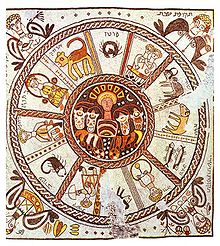
Mosaic in the
Beth Alpha
synagogue, with the sun
in the centre, surrounded by the twelve zodiac constellations and
with the four seasons associated inaccurately with the
constellations
A study of
Augustine of Hippo
remarks that his exhortation
in a Christmas sermon, “Let us celebrate this day as a feast not for the sake of
this sun, which is beheld by believers as much as by ourselves, but for the sake
of him who created the sun”, shows that he was aware of the coincidence of the
celebration of Christmas and the Birthday of the Unconquered Sun, although this
pagan festival was celebrated at only a few places and was originally a
peculiarity of the Roman city calendar. It adds: “He also believes, however,
that there is a reliable tradition which gives 25 December as the actual date of
the birth of our Lord.”
By “the sun of righteousness” in
Malachi 4:2
“the
fathers
, from
Justin
downward, and nearly all the earlier
commentators understand Christ, who is supposed to be described as the
rising sun”.
The
New Testament
itself contains a hymn fragment:
“Awake, O sleeper, and arise from the dead, and Christ will shine on you.”
Clement of Alexandria
wrote of “the Sun of the
Resurrection, he who was born before the dawn, whose beams give light”.
Christians adopted the image of the Sun (Helios
or Sol Invictus) to represent Christ. In this portrayal he is a beardless figure
with a flowing cloak in a chariot drawn by four white horses, as in the mosaic
in Mausoleum M discovered under
Saint Peter’s Basilica
and in an
early-4th-century catacomb fresco.
Clement of Alexandria had spoken of Christ driving his chariot
in this way across the sky. The nimbus of the figure under Saint Peter’s
Basilica is described by some as rayed,
as in traditional pre-Christian representations, but another
has said: “Only the cross-shaped nimbus makes the Christian significance
apparent” (emphasis added). Yet another has interpreted the figure as a
representation of the sun with no explicit religious reference whatever, pagan
or Christian.
The traditional image of the sun is used also in Jewish art. A mosaic floor
in Hamat Tiberias
presents
David
as Helios surrounded by a ring with the
signs of the zodiac
.As well as in Hamat Tiberias, figures of
Helios or Sol Invictus also appear in several of the very few surviving schemes
of decoration surviving from Late Antique
synagogues
, including
Beth Alpha
,
Husefah
(Husefa) and
Naaran
, all now in
Israel
. He is shown in floor mosaics, with the
usual radiate halo, and sometimes in a
quadriga
, in the central roundel of a circular
representation of the zodiac or the seasons. These combinations “may have
represented to an agricultural Jewish community the perpetuation of the annual
cycle of the universe or … the central part of a calendar”.
VALERIAN I

Augustus:
A.D. 253-260 with Gallienus
Husband of Mariniana
Father of Gallienus
Grandfather of Valerian II and Saloninus
Publius Licinius Valerianus (c. 200 – after 260),
commonly known in
English
as Valerian or Valerian I,
was the
Roman Emperor
from 253 to 260.
Unlike the majority of the pretenders during the
Crisis of the Third Centuryy
, Valerian was of a
noble and traditional
senatorial
family. Details of his early life
are elusive, but for his marriage to
Egnatia Mariniana
, who gave him two sons: later
emperor Publius Licinius Egnatius Gallienus
and
Valerianus Minor
.
In 238 he was
princeps senatus
, and
Gordian I
negotiated through him for Senatorial
acknowledgement for his claim as emperor. In 251, when
Decius
revived the censorship with legislative
and executive powers so extensive that it practically embraced the civil
authority of the emperor, Valerian was chosen
censor
by the Senate, though he declined to
accept the post. Under Decius he was nominated governor of the
Rhine
provinces of
Noricum
and
Raetia
and retained the confidence of his
successor,
Trebonianus Gallus
, who asked him for
reinforcements to quell the rebellion of
Aemilianus

Coin of
Egnatia Mariniana
, wife of Valerian
and mother of
Gallienus
.
Rule and fall
Valerian’s first act as emperor was to make his son Gallienus
his colleague. In the beginning of his reign the affairs in Europe went from bad
to worse and the whole West fell into disorder. In the East,
Antioch
had fallen into the hands of a
Sassanid
vassal,
Armenia
was occupied by
Shapur I
(Sapor). Valerian and Gallienus split
the problems of the empire between the two, with the son taking the West and the
father heading East to face the
Persian
threat.
By 257, Valerian had already recovered Antioch and returned
the province of
Syria
to Roman control but in the following
year, the Goths
ravaged
Asia Minor
. Later in 259, he moved to
Edessa
, but an outbreak of
plague
killed a critical number of
legionaries
, weakening the Roman position in
Edessa which was then besieged by the Persians. At the beginning of 260,
Valerian was defeated in the
Battle of Edessa
and he arranged a meeting with
Shapur to negotiate a peace settlement. The ceasefire was betrayed by Shapur who
seized him and held him prisoner for the remainder of his life. Valerian’s
capture was a humiliating defeat for the Romans.
Gibbon
, in
The History of the Decline and Fall of the Roman Empire
describes Valerian’s fate:
The voice of history, which is often little more than the
organ of hatred or flattery, reproaches Sapor with a proud abuse of the
rights of conquest. We are told that Valerian, in chains, but invested with
the Imperial purple, was exposed to the multitude, a constant spectacle of
fallen greatness; and that whenever the Persian monarch mounted on
horseback, he placed his foot on the neck of a Roman emperor.
Notwithstanding all the remonstrances of his allies, who repeatedly advised
him to remember the vicissitudes of fortune, to dread the returning power of
Rome, and to make his illustrious captive the pledge of peace, not the
object of insult, Sapor still remained inflexible. When Valerian sunk under
the weight of shame and grief, his skin, stuffed with straw, and formed into
the likeness of a human figure, was preserved for ages in the most
celebrated temple of Persia; a more real monument of triumph, than the
fancied trophies of brass and marble so often erected by Roman vanity. The
tale is moral and pathetic, but the truth of it may very fairly be called in
question. The letters still extant from the princes of the East to Sapor are
manifest forgeries; nor is it natural to suppose that a jealous monarch
should, even in the person of a rival, thus publicly degrade the majesty of
kings. Whatever treatment the unfortunate Valerian might experience in
Persia, it is at least certain that the only emperor of Rome who had ever
fallen into the hands of the enemy, languished away his life in hopeless
captivity.
Valerian’s massacre of 258
According to the
Catholic Encyclopedia
article on
Valerian
:
Pope Sixtus
was seized on 6 August, 258, in
one of the Catacombs and was put to death;
Cyprian of Carthage
suffered martyrdom on
14 September. Another celebrated martyr was the Roman deacon
St. Lawrence
. In Spain Bishop
Fructuosus of Tarragona
and his two deacons
were put to death on 21 January, 259. There were also executions in the
eastern provinces (Eusebius, VII, xii). Taken altogether, however, the
repressions were limited to scattered spots and had no great success..
Death in captivity
An early Christian source,
Lactantius
, maintained that for some time prior
to his death Valerian was subjected to the greatest insults by his captors, such
as being used as a human footstool by Shapur when mounting his horse. According
to this version of events, after a long period of such treatment Valerian
offered Shapur a huge ransom for his release. In reply, according to one
version, Shapur was said to have forced Valerian to swallow molten gold (the
other version of his death is almost the same but it says that Valerian was
killed by being flayed alive) and then had the unfortunate Valerian skinned and
his skin stuffed with straw and preserved as a trophy in the main Persian
temple. It was further alleged by Lactantius that it was only after a later
Persian defeat against Rome that his skin was given a cremation and burial. The
role of a Chinese prince held hostage by Shapur I, in the events following the
death of Valerian has been frequently debated by historians, without reaching
any definitive conclusion.
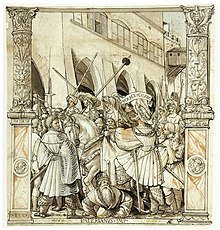
The Humiliation of Emperor Valerian by
Shapur I
, pen and ink,
Hans Holbein the Younger
, ca. 1521
Some modern scholars believe that, contrary to Lactantius’
account, Shapur I
sent Valerian and some of his army to
the city of Bishapur
where they lived in relatively good
condition. Shapur used the remaining soldiers in engineering and development
plans. Band-e Kaisar (Caesar’s dam) is one of the remnants of Roman
engineering located near the ancient city of
Susa. In all the stone carvings on Naghshe-Rostam, in Iran, Valerian
is respected by holding hands with Shapur I, in sign of submission.
It is generally supposed that some of
Lactantius
‘ account is motivated by his desire
to establish that persecutors of the Christians died fitting deaths; the story
was repeated then and later by authors in the Roman Near East “fiercely hostile”
to Persia.
Other modern scholars tend to give at least some credence to
Lactantius’ account.
Valerian and Gallienus’ joint rule was threatened several
times by
usurpers
. Despite several usurpation attempts,
Gallienus secured the throne until his own assassination in 268.
Owing to imperfect and often contradictory sources, the
chronology and details of this reign are very uncertain..
|






